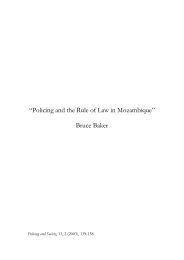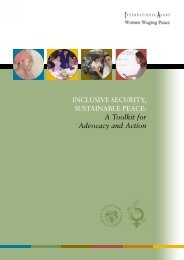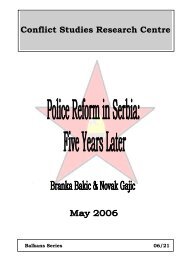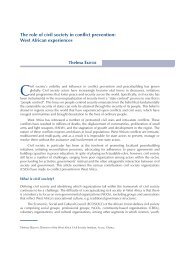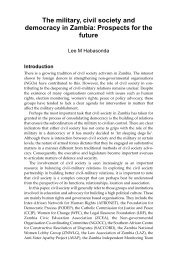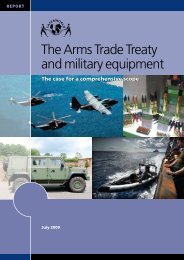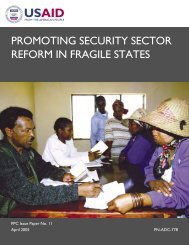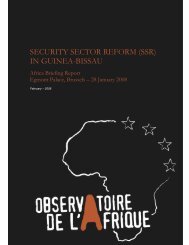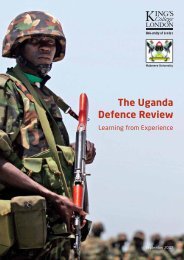small arms and light weapons among pastoral groups in the kenya ...
small arms and light weapons among pastoral groups in the kenya ...
small arms and light weapons among pastoral groups in the kenya ...
Create successful ePaper yourself
Turn your PDF publications into a flip-book with our unique Google optimized e-Paper software.
SALW AMONG PASTORAL GROUPS 55<br />
<strong>the</strong>y often used <strong>the</strong>ir guns <strong>in</strong> <strong>the</strong>ir own battles, not only to protect but also<br />
to raid <strong>and</strong> sell <strong>arms</strong> <strong>and</strong> ammunition. 45<br />
Teso <strong>and</strong> Lango have created <strong>the</strong>ir own vigilantes to defend <strong>the</strong>mselves<br />
aga<strong>in</strong>st <strong>the</strong> Karimojong. These are known as Arrow boys <strong>and</strong> Amuka boys.<br />
On 22 March 2000, an assortment of <strong>weapons</strong> was given by <strong>the</strong> government<br />
to <strong>the</strong> people (youth) of Teso District to defend <strong>the</strong>mselves aga<strong>in</strong>st<br />
Karimojong raiders. 46 It was also reported that each district had been<br />
required to provide 700 youths for tra<strong>in</strong><strong>in</strong>g by <strong>the</strong> army. At a workshop<br />
held <strong>in</strong> Ug<strong>and</strong>a, one participant commented: ‘When <strong>the</strong>re is trouble <strong>the</strong><br />
government will come with guns <strong>and</strong> distribute <strong>the</strong>m, also, government<br />
adm<strong>in</strong>istration <strong>and</strong> chiefs are <strong>in</strong>volved, it is well known some get 10 per<br />
cent of <strong>the</strong> loot, <strong>and</strong> so will not expose <strong>the</strong> culprits no matter how much<br />
<strong>the</strong> community identifies <strong>the</strong>m’. 47 In November 2004, a Karimojong<br />
elder claimed that <strong>the</strong>y were fearful of <strong>the</strong>se vigilante <strong>groups</strong>, because<br />
<strong>the</strong> government was plann<strong>in</strong>g to use <strong>the</strong>m disguised as UPDF to disarm<br />
<strong>the</strong> Karimojong. This caused a reactionary <strong>in</strong>crease <strong>in</strong> <strong>small</strong> <strong>arms</strong> <strong>in</strong><br />
Karamoja. 48<br />
There are o<strong>the</strong>r examples of <strong>the</strong> government arm<strong>in</strong>g warriors. After <strong>the</strong><br />
failed first disarmament 2001–3, 49 <strong>in</strong>security escalated as <strong>the</strong> Pian found<br />
<strong>the</strong>mselves victims. The Ug<strong>and</strong>a government responded by re-arm<strong>in</strong>g <strong>the</strong><br />
Pian home guards. Interviews noted that nearly 650 guns were h<strong>and</strong>ed out.<br />
This was done for <strong>the</strong> purpose of build<strong>in</strong>g confidence <strong>among</strong> <strong>the</strong> Pian<br />
home guards who were considered vulnerable to attacks from neighbour<strong>in</strong>g<br />
ethnic <strong>groups</strong>. This is a worry<strong>in</strong>g scenario given that <strong>the</strong> purpose of disarmament<br />
was to remove <strong>the</strong> <strong>weapons</strong> from <strong>the</strong> society. Arm<strong>in</strong>g one<br />
community triggers o<strong>the</strong>rs to dem<strong>and</strong> <strong>arms</strong> from <strong>the</strong> state <strong>and</strong> leads to<br />
more diffusion <strong>and</strong> weaponization of <strong>the</strong> communities. Fur<strong>the</strong>rmore, any<br />
<strong>arms</strong> collected should have been destroyed to avoid <strong>the</strong> same <strong>arms</strong> return<strong>in</strong>g<br />
to <strong>the</strong> community.<br />
On <strong>the</strong> Kenyan side of <strong>the</strong> border, <strong>the</strong> government has provided <strong>arms</strong> to<br />
<strong>the</strong> KPRs who are under <strong>the</strong> control of <strong>the</strong> police <strong>and</strong> district commissioners.<br />
The KPRs were established <strong>in</strong> 1948 to augment <strong>the</strong> activities of <strong>the</strong><br />
regular police force <strong>and</strong> <strong>in</strong> <strong>pastoral</strong> areas of Kenya, <strong>and</strong> <strong>the</strong> force has been<br />
45. Mkutu, Pastoral Conflict, Governance <strong>and</strong> Small Arms (chapter 4).<br />
46. The Monitor, 22 March 2000.<br />
47. Inter-African Bureau for Animal Resources (IBAR) <strong>and</strong> Organisation of African Unity<br />
(OAU) <strong>pastoral</strong> community harmonization meet<strong>in</strong>g held at Mount Elgon Hotel, Mbale,<br />
Ug<strong>and</strong>a, May 2001.<br />
48. These were recognized by <strong>the</strong>ir language especially <strong>in</strong> Bokora: <strong>in</strong>terviews <strong>in</strong> Lotome,<br />
November 2004.<br />
49. For more on <strong>the</strong> disarmaments, see Mkutu, ‘Guns <strong>and</strong> Governance’; Kennedy Mkutu,<br />
‘Pastoralist conflict <strong>and</strong> <strong>small</strong> <strong>arms</strong>: <strong>the</strong> challenges of <strong>small</strong> <strong>arms</strong> <strong>and</strong> <strong>in</strong>security <strong>and</strong> attempts<br />
at management <strong>in</strong> Karamoja, Ug<strong>and</strong>a’ (Paper presented at <strong>the</strong> Nor<strong>the</strong>ast Africa Sem<strong>in</strong>ar,<br />
Institute of Social <strong>and</strong> Cultural Anthropology, University of Oxford, 30 January 2004); From<br />
2004 to January 2006, 1,068 <strong>arms</strong> have been recovered forcibly <strong>and</strong> voluntarily <strong>in</strong> <strong>the</strong> four<br />
districts of Karamoja. See Daily Monitor, 9 January 2006.




